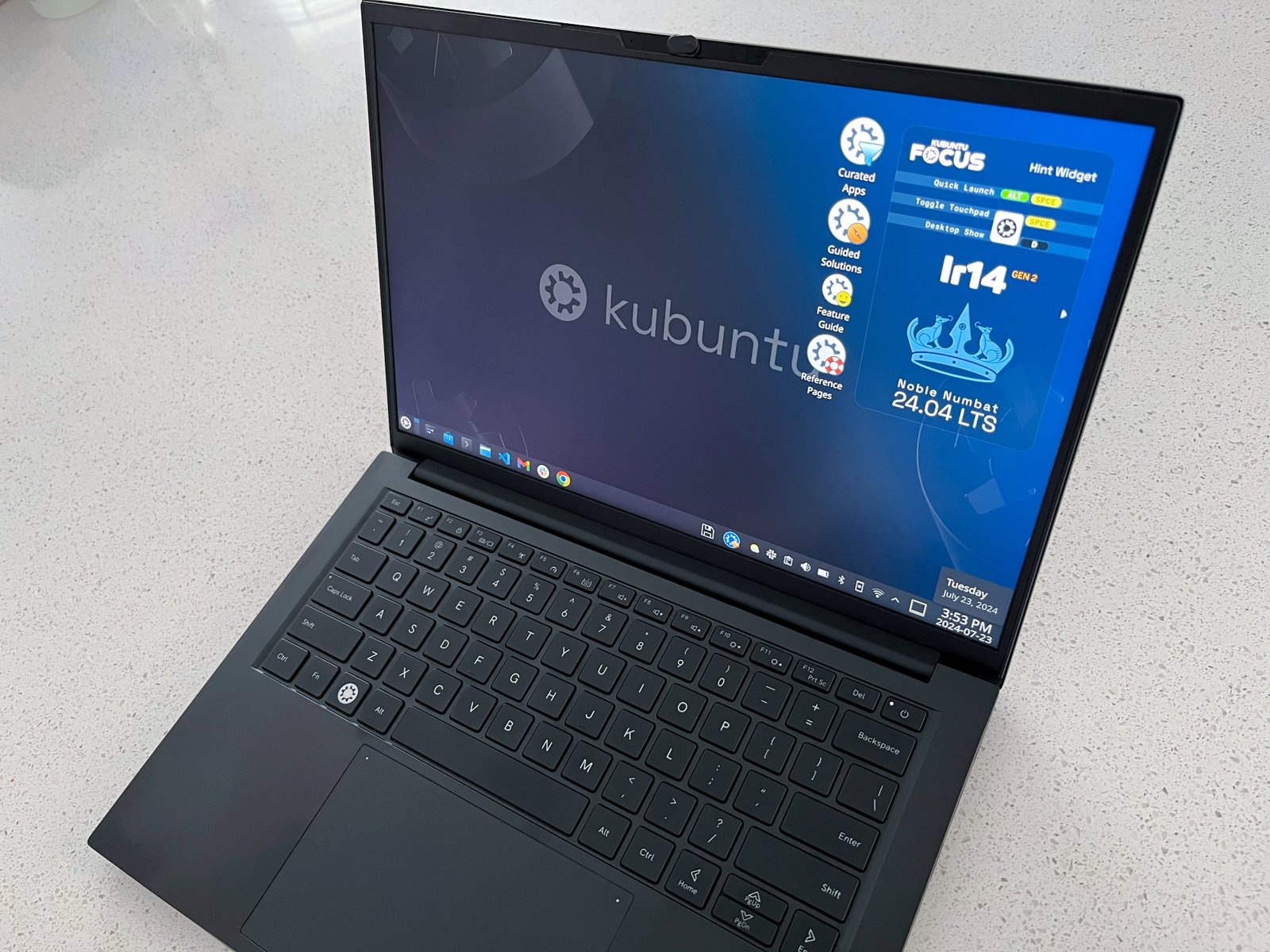
Kubuntu Focus Ir14 Gen 2 review: Using Linux instead of messing with it
-
by Anoop Singh
- 5
The physical laptop
| Specs at a glance: Kubuntu Focus Ir14 Gen 2 | |
|---|---|
| Display | 14-inch IPS panel: 1920×1200 (16:10), 60 Hz, 350cd/m², 1,200:1 max contrast, 145-degree open angle |
| OS | Kubuntu 24.04 |
| CPU | Intel Core i5-13500H (4.7 GHz turbo, 12 cores, 18MB cache) |
| RAM | 16 GB DDR5-4800 (as reviewed), up to 96GB DDR5-5200 |
| GPU | Intel Iris Xe (80 execution units, 1.45 GHz) |
| Storage | 2 x M.2 2280 NVMe PCIe 4×4 (500GB as reviewed) |
| Networking | Intel Wi-Fi 6AX 201, Dual-mode Bluetooth 5.2 |
| Power/Battery | 53 WHr battery, 90-minute fast charge (90 W barrel or 100 W USB-C), 5-8 hours battery |
| Ports |
|
| Size | 12.4×8.6×0.7 in (315× 218×18 mm) |
| Weight | 3 lbs (1.36 kg) |
| Price as reviewed | $1,080 |
There’s not much to say about the hardware experience of the Ir14 Gen 2. The look and feel screams “fleet,” though a bit lighter and sleeker than the ThinkPads and HP Somethings of that realm. It weighs 3 pounds, the chassis is magnesium alloy, and the screen is a matte 14-inch FHD panel. The webcam is a 2 MP 1080p model, and you look about as bad as on every other laptop. The keyboard is backlit, and the Super/Win key is a little Kubuntu icon, which is cute.
Inside is an Intel Core i5-13500H Raptor Lake chip, and you can pack in up to 96GB of DDR5-5200 memory. Packing it in is easy, too, as this laptop is easy as heck to open, upgrade, and fix. You can slot up to two M.2 NVMe SSDs inside (PCIe 4.0 x 4) (at the starting price of $1,080, you get 500GB storage and 16GB RAM). And the port selection is quite good: A full-size HDMI 2.1, Thunderbolt 4, USB 3.2 Gen 2 Type-C, two (2!) USB 3.1 Type-A ports, a stereo jack, and a microSD card reader.
The most notable feature on any non-Apple laptop I test, the trackpad, gets a solid 7/10 from me. I could almost imagine using it in tap-to-click mode, but a few errant clicks and painful box selections led me back to my default click-to-click setting. I wondered if there were more settings available than the relatively few I saw, checked the help docs, and, yes, of course: Focus explained its choice of using Libinput by default instead of Synaptics touchpad tools. Neither one really got me to where I was totally comfortable with tap-to-click on that pad, but sparing me from the what-if rabbit hole is a value add.
The other two hardware notes: The webcam has a built-in privacy cover, but it’s a fussy little flap that I found hard to move around on my unit; the keyboard was responsive, had decent depth, and was both labeled clearly and backlit. It’s a perfectly cromulent portal to the software, which is what really matters here.
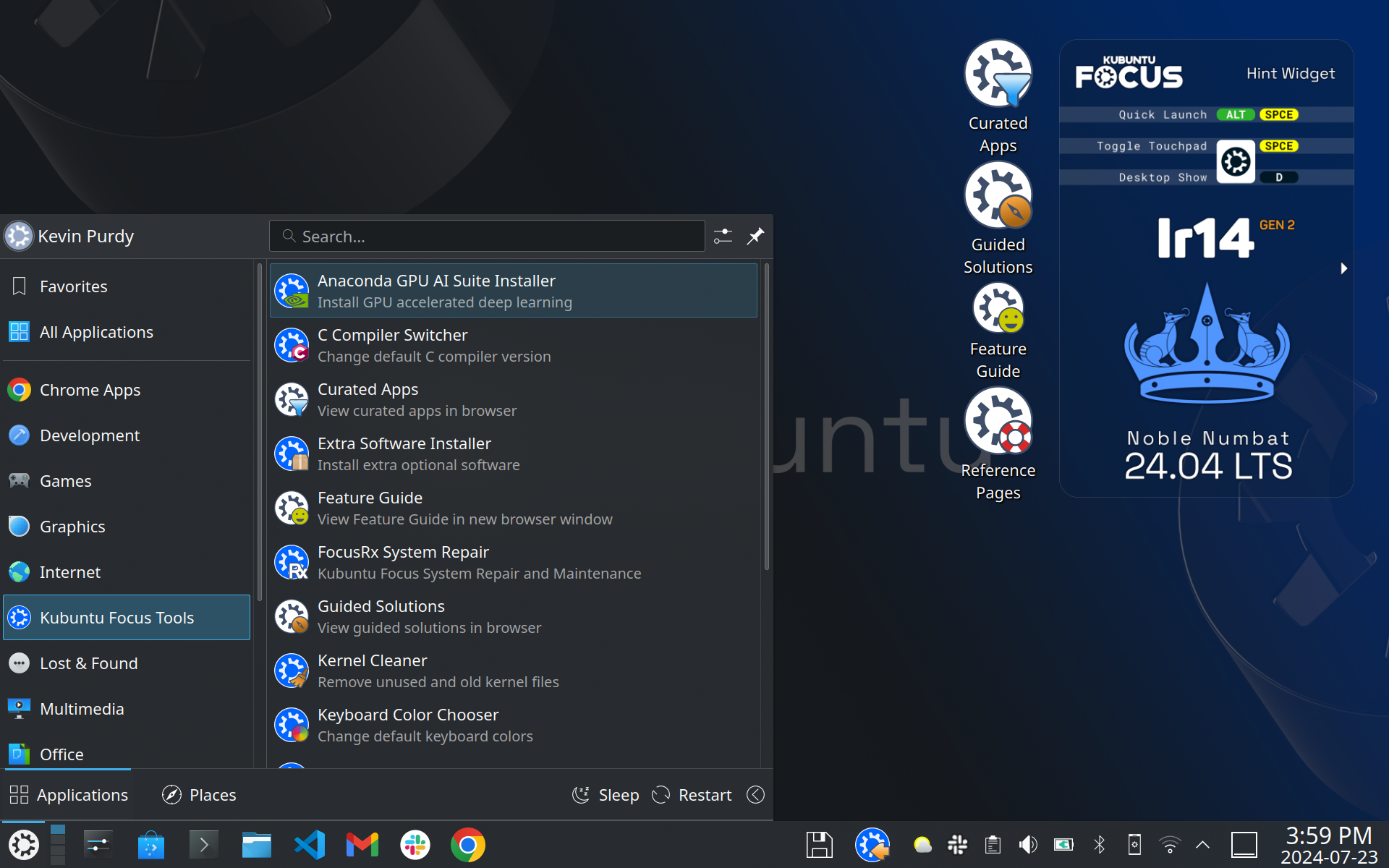
The Kubuntu Focus desktop on the Ir14 Gen 2.
Credit:
Ars Technica
The Kubuntu Focus experience
I do not usually start out intending to use Linux on a laptop; it’s typically something that comes later. One time, I ordered a laptop through a job and made the brave choice to forego a Windows license, thinking I was saving that employer some cash and proving my open source mettle. After a team meeting in which a coworker told me I had to either mute my robo-sounding self or call in by phone, I sheepishly expensed a Windows 11 key and absorbed a tough lesson.
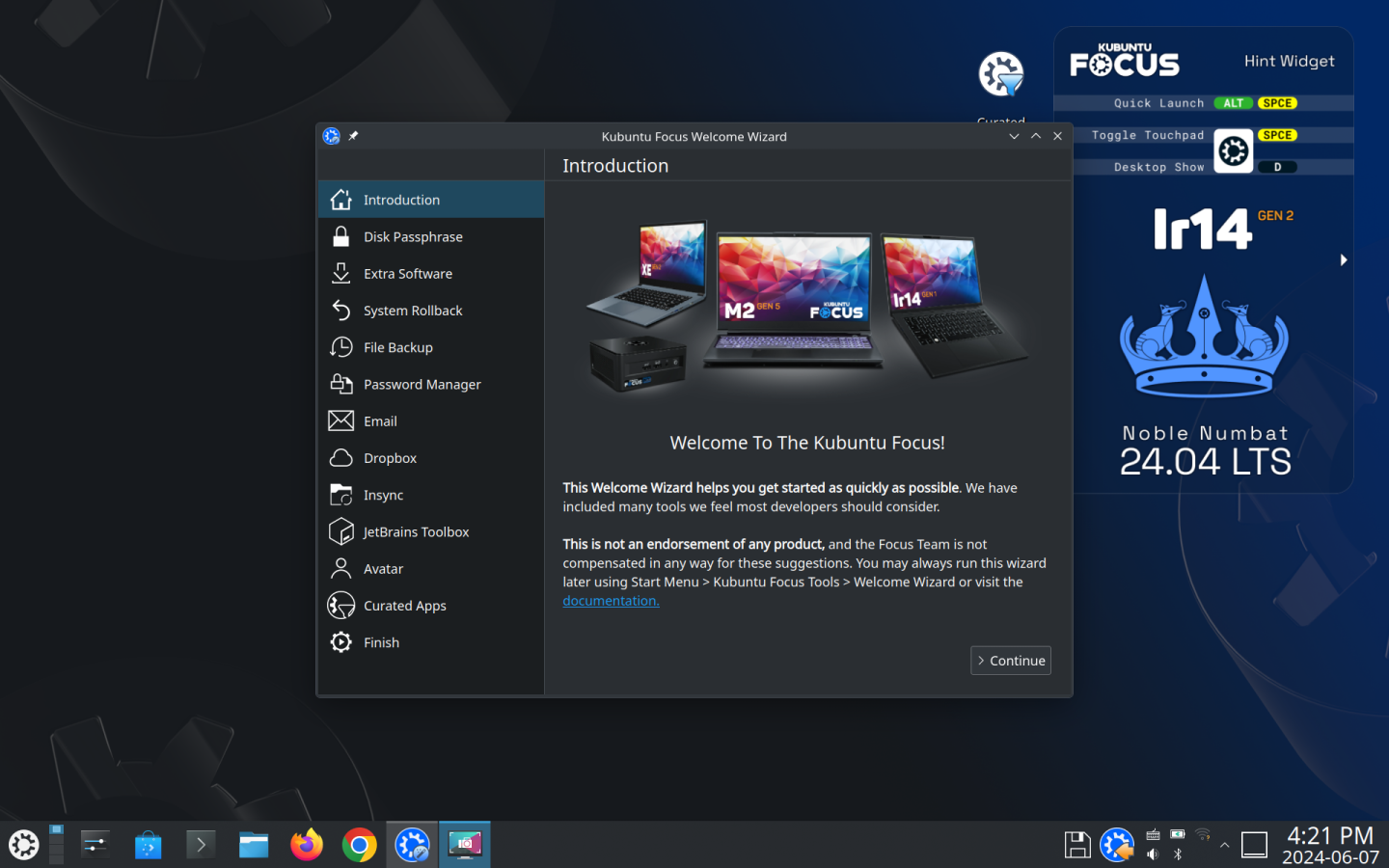
Ars Technica
Setting up the Kubuntu Focus for the first time, you’re met by a wizard that can walk you through each (optional) step.
Ars Technica
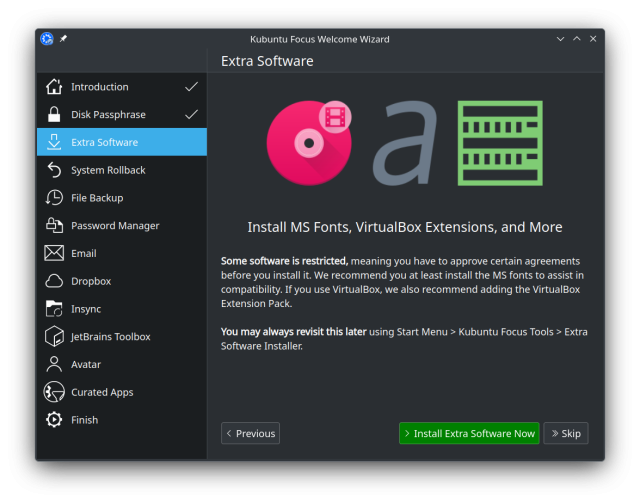
Ars Technica
The defaults and suggestions are good, and a lot of what would be recommended on any system.
Ars Technica
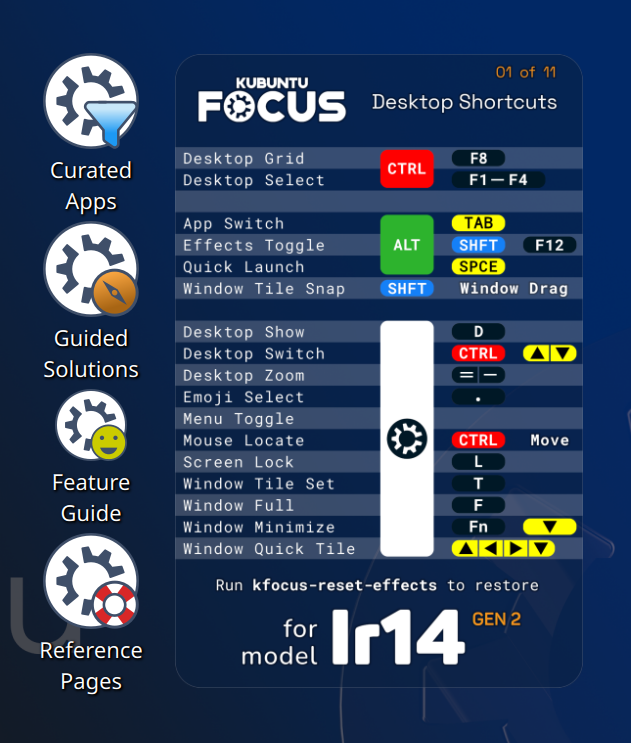
Ars Technica
Close-up on the desktop widget and web links that ship with the Focus, the first few detailing keyboard shortcuts.
Ars Technica
The defaults and suggestions are good, and a lot of what would be recommended on any system.
Ars Technica
Close-up on the desktop widget and web links that ship with the Focus, the first few detailing keyboard shortcuts.
Ars Technica
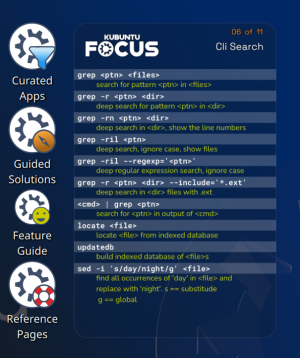
Ars Technica
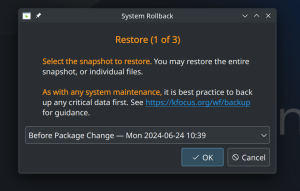
Ars Technica
Setting up and using the Ir14 Gen 2 was the opposite of that experience. It was almost too nice to me, guiding me through the initial setup with questions, suggestions, wizards, and tutorials, then leaving key apps and helper widgets on the desktop, just in case I forgot a keyboard shortcut or had a question. It messed with my sense of Linux as Undiscovered Badlands, but it also helped me get to work faster.
That helper widget is pretty danged helpful, too. It has 11 pages you can flip through, ranging from the basics of your system (raising or lowering volume or screen brightness) to reminders for terminal dilettantes like me on how to search files and their contents with grep.
A core feature of Kubuntu Focus’ devices is the company’s system rollback tool. I didn’t have any real reason to test this, but I did have at least one kernel update during my testing. Pretending as if I wanted to go back, I chose a time before that patch, hit the button, made myself a coffee, and when I came back (and entered my encryption/user passwords), the system was back up with a note about what had happened. Having that kind of option in my mental back pocket makes an already stable system feel like it’s on rails.
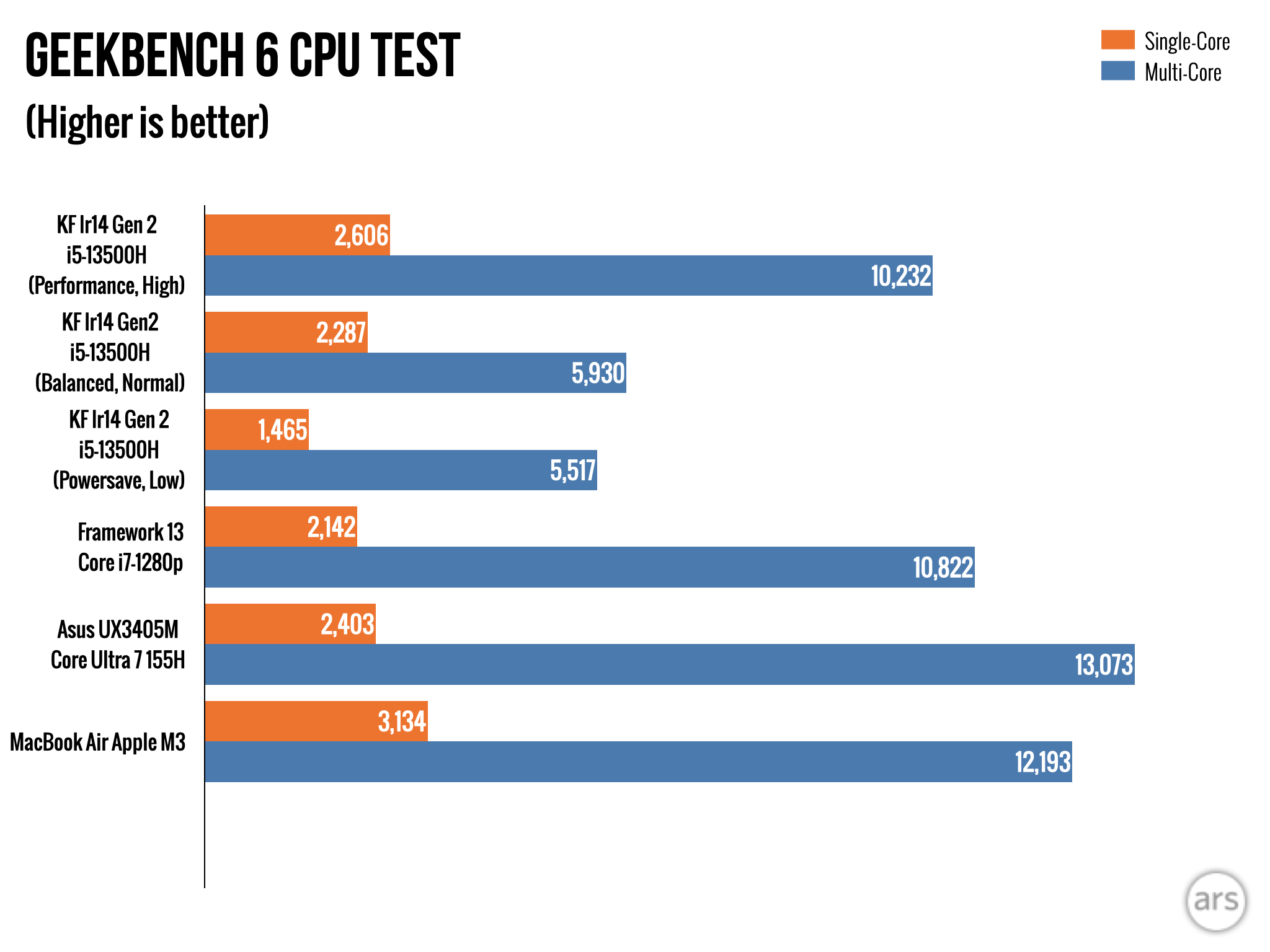
Geekbench 6 results for the Kubuntu Focus Ir14 Gen 2, along with laptops from Framework, Asus, and Apple.
Credit:
Ars Technica
Performance (and not worrying about it)
This is not the Kubuntu Focus system to get if you need the most power; the Focus M2 Gen 5 is for that. The company posted its own Geekbench 5 numbers for its system, and I ran it through Geekbench 6 (just above). The Focus team alerted me halfway through my testing that they noticed a hiccup in Geekbench results and pointed me toward an early kernel patch to address it.
The power profiles that ship with the Focus laptop are all I could ask for, and you can see their differences in the results above. I worked on Low and Studio settings while away from a plug with little difficulty. High gave me some leeway in playing games through Proton on Steam, but it was mostly unnecessary (and quite loud, fan-noise-wise, though you can of course adjust that in BIOS). Knowing I could kick the system higher or lower, or even tweak the two biggest sliders for battery efficiency, gave me the rare feeling of just using the thing without much concern for whether I was using it right. I got pretty close to the eight hours of battery life the company suggested, for what it’s worth, but with more lid-closed sleep breaks than I’d normally bother with.
That’s my experience with the Kubuntu Focus in a nutshell. It stacks up against System76’s Pangolin laptop in many respects. I prefer the eye-catching look of System76’s Cosmic desktop, but the webcam in the Kubuntu Focus was not quite so gruesome a view of myself. Both had trackpads that did not wow me.
If I had to pick one or the other, I would have to be honest with myself. What was more important: rock-solid stability or a nifty custom-built software feel? Can I answer that viral fake/joke tweet from a couple years back?
Kubuntu Focus makes laptops for researchers, developers, and people who want assurance that—if they don’t reach in and mess with the deeper bits—all their hardware and verified software will work. It’s a bit cliché, but as I’ve gotten older, my desire to mess with things, either for “just right” or “for the heck of it,” has waned considerably, even if my appreciation for Linux and open source tools has not. Kubuntu Focus suggests an intriguing middle path, one you might consider, even outside your employer buying one for you.
This story was updated after publication to reflect that the laptop ships with Kubuntu 24.04, not Kubuntu 22.04.
The physical laptop Specs at a glance: Kubuntu Focus Ir14 Gen 2 Display 14-inch IPS panel: 1920×1200 (16:10), 60 Hz, 350cd/m², 1,200:1 max contrast, 145-degree open angle OS Kubuntu 24.04 CPU Intel Core i5-13500H (4.7 GHz turbo, 12 cores, 18MB cache) RAM 16 GB DDR5-4800 (as reviewed), up to 96GB DDR5-5200 GPU Intel Iris Xe…
The physical laptop Specs at a glance: Kubuntu Focus Ir14 Gen 2 Display 14-inch IPS panel: 1920×1200 (16:10), 60 Hz, 350cd/m², 1,200:1 max contrast, 145-degree open angle OS Kubuntu 24.04 CPU Intel Core i5-13500H (4.7 GHz turbo, 12 cores, 18MB cache) RAM 16 GB DDR5-4800 (as reviewed), up to 96GB DDR5-5200 GPU Intel Iris Xe…
